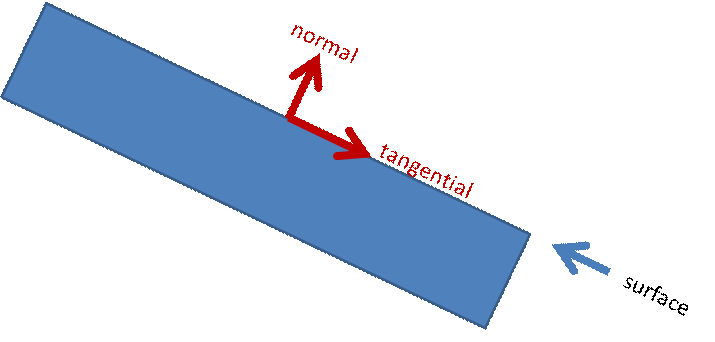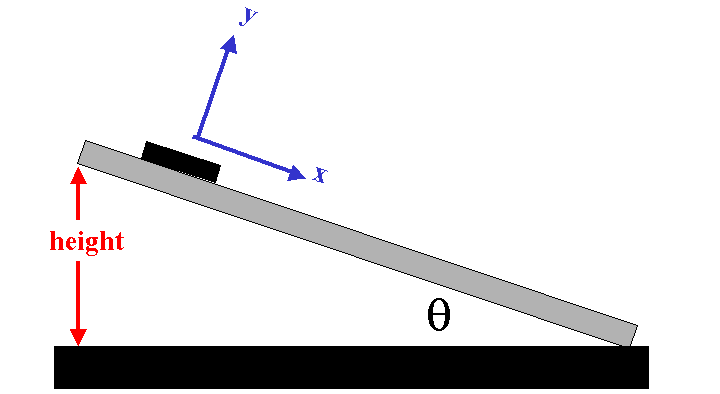

 PYL 105
PYL 105




When an object lies on or moves along a surface, there is a contact force. It is convenient to break that contact force into two components: one "normal" to the surface, the other "tangential" to the surface. In fact, the two components are often discussed as if they are two separate forces. Of course, as we saw previously in the force lab(s), it makes no difference to its effect whether it is two forces or one force (addition of vectors).


The force normal (perpendicular) to the surface is called the normal force. The normal force prevents the object from breaking through the surface. Its magnitude exactly balances the net effect of all other forces in the normal (perpendicular to the surface) direction.
The force along the tangential direction is called the frictional force. Friction behaves slightly differently depending on whether or not the object is moving relative to the surface.
The frictional force is ultimately due to the interaction of the object atoms with the surface atoms and vice versa. The strength (magnitude) of the frictional force might depend on the following:
In the first part of this course, we usually approximate objects by point particles. To keep consistent with this approximation, we assume that the area dependences of the first two considerations above exactly cancel. One is then left with the frictional force being proportional to the force exterted perpendicular to the surface, that is, the normal force. Any material dependence from the third consideration will be encoded in the proportionality constant called the coefficient of friction.
In a static situation, the magnitude of the friction force is whatever it has to be to balance other tangential forces up to some limit, that is,
Ff < μs N,
where N is the magnitude of the normal force and μs is called the coefficient of static friction. The expression μs N is the largest the static friction can be. If the opposing tangential forces exceed it, motion results. The direction of the frictional force is opposite to the direction of motion the object would have in the absence of friction.
Measurements

| Length of track ( ) | |
| Mass of friction block ( ) | |
| Mass of heavy metal block ( ) |

| Height trial 1 ( ) |
Height trial 2 ( ) |
Height trial 3 ( ) |
Angle trial 1 ( ) |
Angle trial 2 ( ) |
Angle trial 3 ( ) |
μs trial 1 |
μs trial 2 |
μs trial 3 |
μs Ave |
μs St. dev. |
|
| Felt Wide | |||||||||||
| Felt Narrow | |||||||||||
| Wood Wide | |||||||||||
| Wood Narow |
| Height trial 1 ( ) |
Height trial 2 ( ) |
Height trial 3 ( ) |
Angle trial 1 ( ) |
Angle trial 2 ( ) |
Angle trial 3 ( ) |
μs trial 1 |
μs trial 2 |
μs trial 3 |
μs Ave |
μs St. dev. |
|
| Friction Block Alone | |||||||||||
| With One Heavy Block | |||||||||||
| With Two Heavy Blocks |
Analysis
When the object is moving along the surface, we have what is called kinetic friction, and in our approximation the formula is
Ff = μk N,
(In the case of kinetic friction we have an equation rather than an inequality; the equation applies provided the object is moving.)
Measurements
| Mass of friction block ( ) | |
| Mass on hanger including hanger ( ) | |
| Mass of metal blocks ( ) |

| Acceleration
( ) |
Coefficient of kinetic fricton
( ) |
|
| Felt Wide | ||
| Wood Wide |
Analysis
Looking at the forces acting on the block and the hanger and breaking the block forces into components yields the following three equations:
| Block | Y comp. | Nb - mbg = 0 |
| Block | X comp. | Tb - μk Nb = mb ab |
| Hanger | Y comp. | mhg - Th = mhah |
where the subscript b indicates block and the subscript h indicates hanger. If the string and pulley are considered massless, then Th=Tb. Furthermore, if the string does not stretch or break then ah=ab. Solve the equations above for μk. Enter the value you find for the coefficient of kinetic friction in the table.
What is the ideal acceleration, that is, the acceleration you would have in the absence of friction?
What are the frictional forces?
What are the coefficients of friction?
Do you observe any dependence on the material?
How do the kinetic coefficients compare to the static coefficients?
